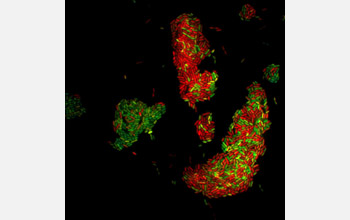Multimedia Gallery
Visualization of Bacterial Chemical Signal
First visualization of the bacterial chemical signal c-di-GMP, that regulates a bacteria's movement. Green bacteria within the aggregate of the bacteria Pseudomonas aeruginosa have higher levels of the chemical.
More about this Image
In reproduction of some species of bacteria, a single-celled organism will split in two and the daughter cell--the swarmer--inherits a propeller to swim freely, while the mother cell builds a stalk to cling to surfaces. Researchers at the University of Washington (UW), along with a colleague at Stanford University, designed biosensors to observe how a bacterium gets the message to divide into these two, functionally and structurally different cells. The biosensors can measure biochemical fluctuations inside a single bacteria cell, which is smaller than an animal or plant cell.
During cell division, a signaling chemical found only in bacteria helps determine the fate of the resulting two cells. The signal is a tiny, circular molecule called cyclic diguanosine monophosphate, or c-di-GMP. By acting as an inside messenger responding to information about the environment outside the bacteria cell, c-di-GMP is implicated in several bacterial survival strategies. In harmless bacteria, some of these tactics keep them alive through harsh conditions. In disease-causing bacteria, c-di-GMP is thought to regulate antibiotic resistance, adhesiveness, biofilm formation and cell motility.
This research was supported by grants from the National Institute of Allergy and Infectious Diseases of the National Institutes of Health, the Swiss National Foundation, the Novartis Foundation, the Cystic Fibrosis Foundation and a graduate research fellowship from the National Science Foundation.
To learn more about this research, see the UW news story "Biosensors reveal how single bacterium gets the message to split into a swimming and a stay-put cell." (Date of Image: August 2009)
Credit: Matthias Christen, Department of Immunology, University of Washington
Images and other media in the National Science Foundation Multimedia Gallery are available for use in print and electronic material by NSF employees, members of the media, university staff, teachers and the general public. All media in the gallery are intended for personal, educational and nonprofit/non-commercial use only.
Images credited to the National Science Foundation, a federal agency, are in the public domain. The images were created by employees of the United States Government as part of their official duties or prepared by contractors as "works for hire" for NSF. You may freely use NSF-credited images and, at your discretion, credit NSF with a "Courtesy: National Science Foundation" notation.
Additional information about general usage can be found in Conditions.
Also Available:
Download the high-resolution JPG version of the image. (441 KB)
Use your mouse to right-click (Mac users may need to Ctrl-click) the link above and choose the option that will save the file or target to your computer.

